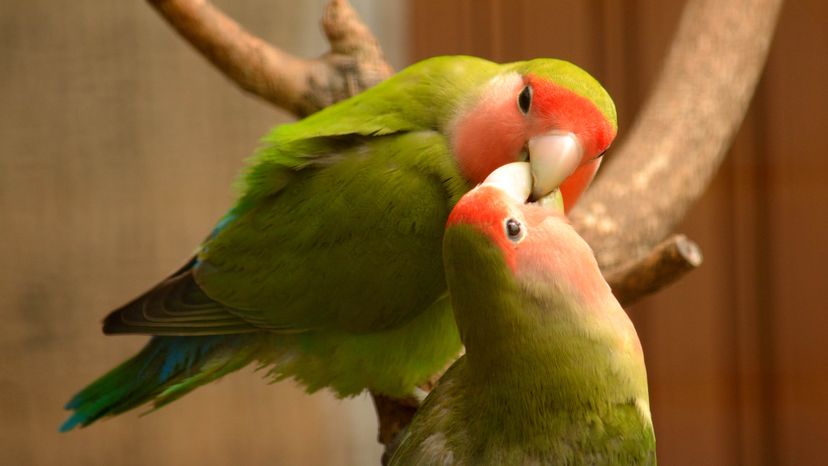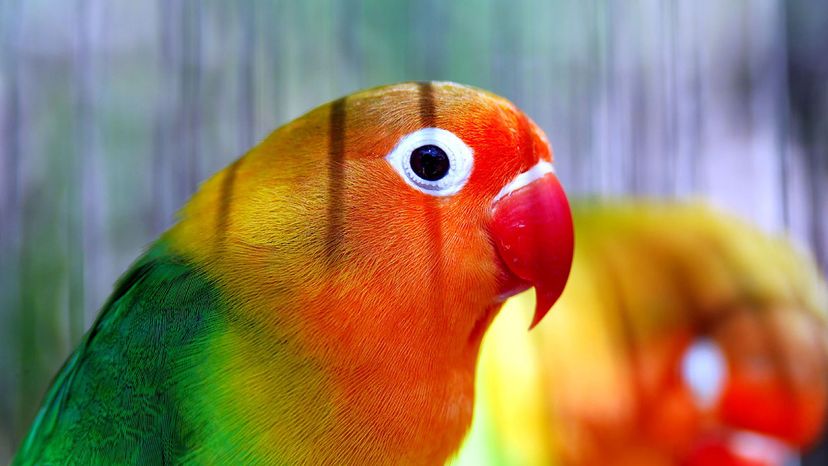
With a name like "lovebird," it seems that these lovely little parrots should be kept in pairs, right? There is a longstanding belief that a solitary lovebird left to its own devices in a cage will become depressed and wither away. However, like much of the information commonly believed about lovebirds, this sad singleton story is a myth, and most lovebirds survive very well on their own, thank you very much.
What are some other key facts about lovebirds? We've tracked down an expert and lovebird owner to discover why lovebirds make such great pets for owners who are willing to shower them with love.
Advertisem*nt
Contents
- Lovebirds Are Great Beginner Birds
- There Are Nine Lovebird Subspecies
- Lovebirds Like to Be Active
- Lovebirds Don't Require a Partner
- Lovebirds Sometimes Can Be Potty Trained
- Lovebirds Like Being Tucked in at Bedtime
- Lovebirds Are Not Talkers
1. Lovebirds Are Great Beginner Birds
Although budgies (parakeets) usually get top billing as popular winged pets, lovebirds are a good candidate for the dedicated beginning or intermediate birdkeeper willing to offer significant time and attention.
Lovebirds are affectionate, sociable and intelligent, three characteristics that make them ideal for people seeking a pet bird, says Julia Scavicchio, a longtime bird hobbyist who has a 4-year-old lovebird, as well as experience caring for co*ckatiels and parakeets, in an email.
Advertisem*nt
"Lovebirds are more similar to the demands of having a dog than having a small pet, such as a hamster," Scavicchio says.
The key to building a solid relationship with a lovebird is to shower your feathered friend with affection from an early age. Adult lovebirds can be tough to tame and often refuse to learn tricks, but a young lovebird will thrive on daily social interaction with its human counterpart. Begin your lovebird relationship tenderly — move slowly and speak softly — then progress to hand-taming. Hand-taming involves gently pressing a dowel or hefty wooden stick to the bird's chest while offering a treat to step onto the dowel. After the lovebird becomes comfortable with this arrangement, you can substitute your finger for the dowel, thus hand-taming your lovebird for close interaction.
2. There Are Nine Lovebird Subspecies
Although you'll often hear lovebirds referred to as a singular group, or by the casual moniker "pocket pet," there are actually nine lovebird subspecies. All lovebirds — with the exception of the lovebird native to the island of Madagascar—originated in Africa. Of the nine subspecies of lovebirds, only three are considered good candidates for pet life because of their charming temperaments: Fischer's lovebird, peach-faced lovebird (aka rosy-faced lovebird) and black-masked lovebird. These three subspecies, like all lovebirds, are diminutive in size. They range from 5 to 6.5 inches (12.7 to 15.2 centimeters), considerably smaller than other parrot species that can measure up to 40 inches (100 centimeters).
"Lovebirds are small, but require a large amount of mental stimulation," says Scavicchio.
Advertisem*nt
3. Lovebirds Like to Be Active
Lovebirds, like their wild compadres, rise at first light to eat, drink and commence with a noisy concerto. They will usually settle down by midmorning, then resume their noise-making by late afternoon. At least once a day, these active birds should be let free from their cages (in a secure room without open windows, of course) and allowed to explore their environment. Both inside and outside of their cages, lovebirds will need a rotating array of toys for stimulation.
"Lovebirds love to run back and forth, and enjoy investigating different textures, so a variety of toys and trinkets can be very interesting for your bird to explore," Scavicchio says.
Advertisem*nt
Ideal lovebird toys include:
- Dye-free paper for them to tear up
- Toys that make noise, such as cat toys with metal bells inside
- Long, straight perches and rope
Advertisem*nt
4. Lovebirds Don't Require a Partner
It is a longstanding myth that lovebirds require a partner. Although these highly social birds travel in flocks in the wild and often are kept in pairs as pets, it is possible to have a single bird that will thrive. In fact, a solitary lovebird will bond deeply with a person who invests time and patience in its care and training. Lovebirds can be quite affectionate with the person who handles them.
"A single lovebird will need much more daily attention compared to a pair of lovebirds," Scavicchio said, "but will also be easier to train, as they are very focused on you."
Advertisem*nt
Conversely, a pair of lovebirds will become so enmeshed in their own relationship that they often will eschew human interaction, preferring to keep to their company. And, they are eager breeders, which could lead to a large lovebird family.
5. Lovebirds Sometimes Can Be Potty Trained
Lovebirds are intelligent and motivated by affection, which makes them ideal learners that can — in some cases — be trained to relieve themselves on command.
"Lovebirds will still go when and where they want, but when you train them to go potty on command it lessens the amount of times they will go when you don't expect it," Scavicchio says. "Lovebirds go potty every 10-15 minutes."
Advertisem*nt
Because lovebirds are eager to please, they can be trained to relieve themselves in a cage before being freed to explore the surrounding environment. Scavicchio recommends pairing a hand gesture and vocal cue, and repeating this (with treats or affection for the desired behavior) in the bird's cage. Once this is mastered, always ask the lovebird to "go potty" before taking them out of the cage. By reinforcing the behavior, the lovebird will become conditioned to relieve itself before leaving the cage.
Advertisem*nt
6. Lovebirds Like Being Tucked in at Bedtime
Lovebirds, like most of us, benefit from a relaxing bedtime routine. Offering a lovebird a tiny tent or a covered "bed" to sleep in will make them feel at home. In the wild, lovebirds get their rest in trees and cacti with cozy holes that they enter when it's time to catch some shut-eye.
Many lovebird keepers have a separate nighttime cage and move the lovebird to that location when it is time to sleep. "Covering the cage helps calm the bird until morning," Scavicchio says.
Advertisem*nt
7. Lovebirds Are Not Talkers
Unlike other parrot species, lovebirds aren't known for being "talkers." They are not typically adept at mimicking speech or sounds. Instead, they like to chatter and chirp.
"The chirps are not a deep sound, as with big-beaked African parrots, nor are they song-like, as with co*ckatiels," Scavicchio says, "but they do make a variety of beeping and buzzing noises that you can choose to pick up on to playfully communicate with them."
Advertisem*nt

Now That's Fascinating
Lovebirds belong to the order Psittaciformes, which includes all parrots. They have a hooked bill and zygodactyl feet, which means that two toes point forward and two toes point backward.
Cite This!
Please copy/paste the following text to properly cite this HowStuffWorks.com article:
Citation